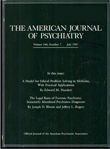Brain proton magnetic resonance spectroscopy (1H-MRS) in Alzheimer's disease: changes after treatment with xanomeline, an M1 selective cholinergic agonist
Abstract
OBJECTIVE: Higher than normal cellular levels of the phospholipid catabolic intermediate glycerophosphocholine have been found in postmortem brain tissue of persons with Alzheimer's disease. Proton magnetic resonance spectroscopy (1H-MRS) can detect a choline resonance that is largely due to glycerophosphocholine. The authors tested the hypothesis that treatment with xanomeline, an M1 selective muscarinic cholinergic agonist, would be associated with a decrease in the 1H-MRS choline resonance. METHOD: Patients with mild to moderate Alzheimer's disease received placebo or xanomeline for 6 months. 1H-MRS spectra were collected at baseline and after treatment discontinuation for 12 patients, two taking placebo and 10 taking xanomeline at a dose of 25 mg t.i.d. (N = 4), 50 mg t.i.d. (N = 3), or 75 mg t.i.d. (N = 3). RESULTS: For the combined group of patients taking xanomeline, there was a significant decrease in the choline/creatine ratio from baseline to endpoint. CONCLUSIONS: Treatment of Alzheimer's disease with a cholinergic agonist is associated with a decrease in the MRS choline resonance. Xanomeline may reduce breakdown of cholinergic neuron membranes by reducing the cellular requirement for free choline for acetylcholine synthesis.



